+ Open data
Open data
- Basic information
Basic information
| Entry | Database: PDB / ID: 7crv | ||||||
|---|---|---|---|---|---|---|---|
| Title | Crystal structure of rNLRP1-FIIND | ||||||
 Components Components | (NLR family protein 1) x 2 | ||||||
 Keywords Keywords | IMMUNE SYSTEM | ||||||
| Function / homology |  Function and homology information Function and homology informationnegative regulation of cellular defense response / NLRP1 inflammasome complex assembly / NLRP1 inflammasome complex / programmed necrotic cell death / self proteolysis / positive regulation of pyroptotic inflammatory response / NLRP3 inflammasome complex / cysteine-type endopeptidase activator activity / Hydrolases; Acting on peptide bonds (peptidases) / cellular response to UV-B ...negative regulation of cellular defense response / NLRP1 inflammasome complex assembly / NLRP1 inflammasome complex / programmed necrotic cell death / self proteolysis / positive regulation of pyroptotic inflammatory response / NLRP3 inflammasome complex / cysteine-type endopeptidase activator activity / Hydrolases; Acting on peptide bonds (peptidases) / cellular response to UV-B / pattern recognition receptor activity / pyroptotic inflammatory response / response to muramyl dipeptide / signaling adaptor activity / antiviral innate immune response / intrinsic apoptotic signaling pathway / activation of innate immune response / positive regulation of interleukin-1 beta production / molecular condensate scaffold activity / protein homooligomerization / positive regulation of inflammatory response / peptidase activity / double-stranded RNA binding / regulation of inflammatory response / double-stranded DNA binding / neuron apoptotic process / scaffold protein binding / regulation of apoptotic process / defense response to virus / defense response to bacterium / inflammatory response / protein domain specific binding / neuronal cell body / enzyme binding / signal transduction / ATP hydrolysis activity / protein-containing complex / ATP binding / nucleus / cytosol Similarity search - Function | ||||||
| Biological species |  | ||||||
| Method |  X-RAY DIFFRACTION / X-RAY DIFFRACTION /  SYNCHROTRON / SYNCHROTRON /  MOLECULAR REPLACEMENT / Resolution: 2 Å MOLECULAR REPLACEMENT / Resolution: 2 Å | ||||||
 Authors Authors | Huang, M.H. / Zhang, X.X. / Wang, J. / Chai, J.J. | ||||||
| Funding support |  China, 1items China, 1items
| ||||||
 Citation Citation |  Journal: Nature / Year: 2021 Journal: Nature / Year: 2021Title: Structural and biochemical mechanisms of NLRP1 inhibition by DPP9. Authors: Menghang Huang / Xiaoxiao Zhang / Gee Ann Toh / Qin Gong / Jia Wang / Zhifu Han / Bin Wu / Franklin Zhong / Jijie Chai /    Abstract: Nucleotide-binding domain, leucine-rich repeat receptors (NLRs) mediate innate immunity by forming inflammasomes. Activation of the NLR protein NLRP1 requires autocleavage within its function-to-find ...Nucleotide-binding domain, leucine-rich repeat receptors (NLRs) mediate innate immunity by forming inflammasomes. Activation of the NLR protein NLRP1 requires autocleavage within its function-to-find domain (FIIND). In resting cells, the dipeptidyl peptidases DPP8 and DPP9 interact with the FIIND of NLRP1 and suppress spontaneous NLRP1 activation; however, the mechanisms through which this occurs remain unknown. Here we present structural and biochemical evidence that full-length rat NLRP1 (rNLRP1) and rat DPP9 (rDPP9) form a 2:1 complex that contains an autoinhibited rNLRP1 molecule and an active UPA-CARD fragment of rNLRP1. The ZU5 domain is required not only for autoinhibition of rNLRP1 but also for assembly of the 2:1 complex. Formation of the complex prevents UPA-mediated higher-order oligomerization of UPA-CARD fragments and strengthens ZU5-mediated NLRP1 autoinhibition. Structure-guided biochemical and functional assays show that both NLRP1 binding and enzymatic activity are required for DPP9 to suppress NLRP1 in human cells. Together, our data reveal the mechanism of DPP9-mediated inhibition of NLRP1 and shed light on the activation of the NLRP1 inflammasome. | ||||||
| History |
|
- Structure visualization
Structure visualization
| Structure viewer | Molecule:  Molmil Molmil Jmol/JSmol Jmol/JSmol |
|---|
- Downloads & links
Downloads & links
- Download
Download
| PDBx/mmCIF format |  7crv.cif.gz 7crv.cif.gz | 152.8 KB | Display |  PDBx/mmCIF format PDBx/mmCIF format |
|---|---|---|---|---|
| PDB format |  pdb7crv.ent.gz pdb7crv.ent.gz | 96.3 KB | Display |  PDB format PDB format |
| PDBx/mmJSON format |  7crv.json.gz 7crv.json.gz | Tree view |  PDBx/mmJSON format PDBx/mmJSON format | |
| Others |  Other downloads Other downloads |
-Validation report
| Summary document |  7crv_validation.pdf.gz 7crv_validation.pdf.gz | 462.4 KB | Display |  wwPDB validaton report wwPDB validaton report |
|---|---|---|---|---|
| Full document |  7crv_full_validation.pdf.gz 7crv_full_validation.pdf.gz | 470.8 KB | Display | |
| Data in XML |  7crv_validation.xml.gz 7crv_validation.xml.gz | 21.5 KB | Display | |
| Data in CIF |  7crv_validation.cif.gz 7crv_validation.cif.gz | 29.1 KB | Display | |
| Arichive directory |  https://data.pdbj.org/pub/pdb/validation_reports/cr/7crv https://data.pdbj.org/pub/pdb/validation_reports/cr/7crv ftp://data.pdbj.org/pub/pdb/validation_reports/cr/7crv ftp://data.pdbj.org/pub/pdb/validation_reports/cr/7crv | HTTPS FTP |
-Related structure data
| Related structure data |  7crwC  3g5bS S: Starting model for refinement C: citing same article ( |
|---|---|
| Similar structure data |
- Links
Links
- Assembly
Assembly
| Deposited unit | 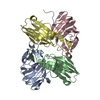
| ||||||||||||
|---|---|---|---|---|---|---|---|---|---|---|---|---|---|
| 1 |
| ||||||||||||
| Unit cell |
|
- Components
Components
| #1: Protein | Mass: 20764.316 Da / Num. of mol.: 2 / Fragment: ZU5 domain Source method: isolated from a genetically manipulated source Source: (gene. exp.)   #2: Protein | Mass: 17649.637 Da / Num. of mol.: 2 / Fragment: UPA domain Source method: isolated from a genetically manipulated source Source: (gene. exp.)   |
|---|
-Experimental details
-Experiment
| Experiment | Method:  X-RAY DIFFRACTION / Number of used crystals: 1 X-RAY DIFFRACTION / Number of used crystals: 1 |
|---|
- Sample preparation
Sample preparation
| Crystal | Density Matthews: 2.07 Å3/Da / Density % sol: 40.72 % |
|---|---|
| Crystal grow | Temperature: 291 K / Method: vapor diffusion, hanging drop Details: 1.0M Ammonium sulfate, 0.1M Bis-Tris pH 5.5, 1% w/v polyethylene glycol 3350 |
-Data collection
| Diffraction | Mean temperature: 100 K / Serial crystal experiment: N |
|---|---|
| Diffraction source | Source:  SYNCHROTRON / Site: SYNCHROTRON / Site:  SSRF SSRF  / Beamline: BL17U1 / Wavelength: 0.979 Å / Beamline: BL17U1 / Wavelength: 0.979 Å |
| Detector | Type: DECTRIS EIGER X 16M / Detector: PIXEL / Date: Oct 25, 2019 |
| Radiation | Protocol: SINGLE WAVELENGTH / Monochromatic (M) / Laue (L): M / Scattering type: x-ray |
| Radiation wavelength | Wavelength: 0.979 Å / Relative weight: 1 |
| Reflection | Resolution: 2→50 Å / Num. obs: 43870 / % possible obs: 99.9 % / Redundancy: 19.3 % / Biso Wilson estimate: 31.87 Å2 / CC1/2: 0.997 / Net I/σ(I): 30.9 |
| Reflection shell | Resolution: 2→2.03 Å / Num. unique obs: 4107 / CC1/2: 0.776 |
- Processing
Processing
| Software |
| |||||||||||||||||||||||||||||||||||||||||||||||||||||||||||||||||||||||||||||||||||||||||||||||||||||||||||||||||||||||
|---|---|---|---|---|---|---|---|---|---|---|---|---|---|---|---|---|---|---|---|---|---|---|---|---|---|---|---|---|---|---|---|---|---|---|---|---|---|---|---|---|---|---|---|---|---|---|---|---|---|---|---|---|---|---|---|---|---|---|---|---|---|---|---|---|---|---|---|---|---|---|---|---|---|---|---|---|---|---|---|---|---|---|---|---|---|---|---|---|---|---|---|---|---|---|---|---|---|---|---|---|---|---|---|---|---|---|---|---|---|---|---|---|---|---|---|---|---|---|---|---|
| Refinement | Method to determine structure:  MOLECULAR REPLACEMENT MOLECULAR REPLACEMENTStarting model: 3G5B Resolution: 2→28.76 Å / SU ML: 0.2651 / Cross valid method: FREE R-VALUE / σ(F): 1.36 / Phase error: 28.6481 Stereochemistry target values: GeoStd + Monomer Library + CDL v1.2
| |||||||||||||||||||||||||||||||||||||||||||||||||||||||||||||||||||||||||||||||||||||||||||||||||||||||||||||||||||||||
| Solvent computation | Shrinkage radii: 0.9 Å / VDW probe radii: 1.11 Å / Solvent model: FLAT BULK SOLVENT MODEL | |||||||||||||||||||||||||||||||||||||||||||||||||||||||||||||||||||||||||||||||||||||||||||||||||||||||||||||||||||||||
| Displacement parameters | Biso mean: 37.34 Å2 | |||||||||||||||||||||||||||||||||||||||||||||||||||||||||||||||||||||||||||||||||||||||||||||||||||||||||||||||||||||||
| Refinement step | Cycle: LAST / Resolution: 2→28.76 Å
| |||||||||||||||||||||||||||||||||||||||||||||||||||||||||||||||||||||||||||||||||||||||||||||||||||||||||||||||||||||||
| Refine LS restraints |
| |||||||||||||||||||||||||||||||||||||||||||||||||||||||||||||||||||||||||||||||||||||||||||||||||||||||||||||||||||||||
| LS refinement shell |
|
 Movie
Movie Controller
Controller





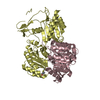
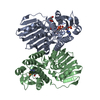

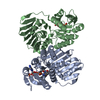
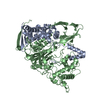
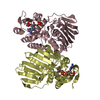
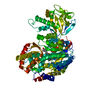


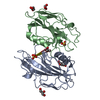
 PDBj
PDBj








